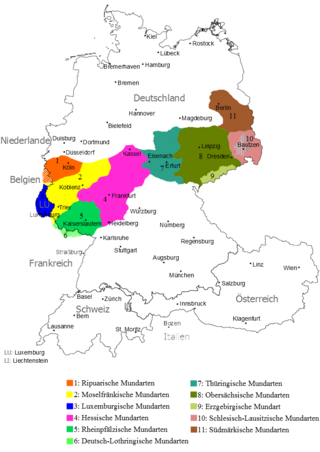| Revision as of 08:51, 16 January 2015 editYobot (talk | contribs)Bots4,733,870 editsm Removed invisible unicode characters + other fixes, replaced: → using AWB (10770)← Previous edit | Revision as of 10:51, 25 November 2016 edit undo89.249.75.206 (talk) →Further readingNext edit → | ||
| Line 38: | Line 38: | ||
| ==Further reading== | ==Further reading== | ||
| * Keller, R. E. (1960) ''German Dialects: phonology and morphology''. Manchester |
* Keller, R. E. (1960) ''German Dialects: phonology and morphology''. Manchester University Press. | ||
| {{-}} | |||
| ==References== | ==References== | ||
Revision as of 10:51, 25 November 2016
| This article needs additional citations for verification. Please help improve this article by adding citations to reliable sources. Unsourced material may be challenged and removed. Find sources: "East Central German" – news · newspapers · books · scholar · JSTOR (December 2009) (Learn how and when to remove this message) |
| East Central German | |
|---|---|
| Native to | Germany |
| Region | Thuringia, Saxony, Berlin, Brandenburg |
| Language family | Indo-European
|
| Language codes | |
| ISO 639-3 | – |
| Glottolog | None |
 Central German dialects
Thuringian (7)
Upper Saxon (8)
Erzgebirgisch (9)
Lusatian (10)
Berlin Brandenburgish (11) Central German dialects
Thuringian (7)
Upper Saxon (8)
Erzgebirgisch (9)
Lusatian (10)
Berlin Brandenburgish (11) | |
East Central German is the eastern, non-Franconian sub-group of Central German dialects, themselves part of High German. Present-day Standard German as a High German variant has actually developed from a compromise of East Central (especially Upper Saxon promoted by Johann Christoph Gottsched) and East Franconian German. East Central German dialects are mainly spoken in Central Germany and parts of Brandenburg, and were formerly also spoken in Silesia and Bohemia.
Dialects
East Central German is spoken in large parts of what is today known as the cultural area of Central Germany (Mitteldeutschland). It comprises:
- Thuringian (Thüringisch)
- Upper Saxon German (Obersächsisch)
- Erzgebirgisch
- Lower and Upper Lusatian (Lausitzisch)
- Berlin-Brandenburgish (Südmärkisch), as distinct from Low German Brandenburgish (Markish)
and further:
- Silesian German (Schlesisch) (nearly extinct)
- High Prussian (Hochpreußisch) (nearly extinct)
See also
Further reading
- Keller, R. E. (1960) German Dialects: phonology and morphology. Manchester University Press.
References
- "Ethnologue: East Middle German". Retrieved 2010-11-24.